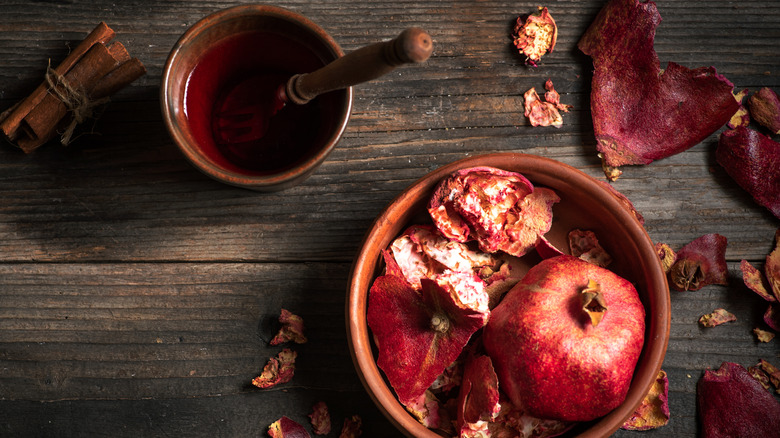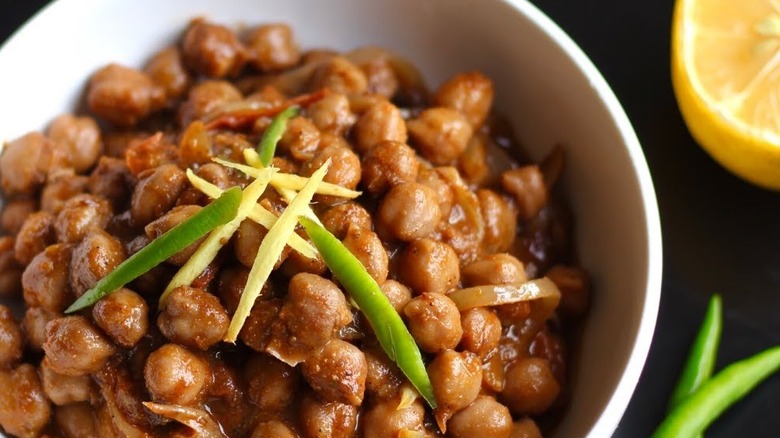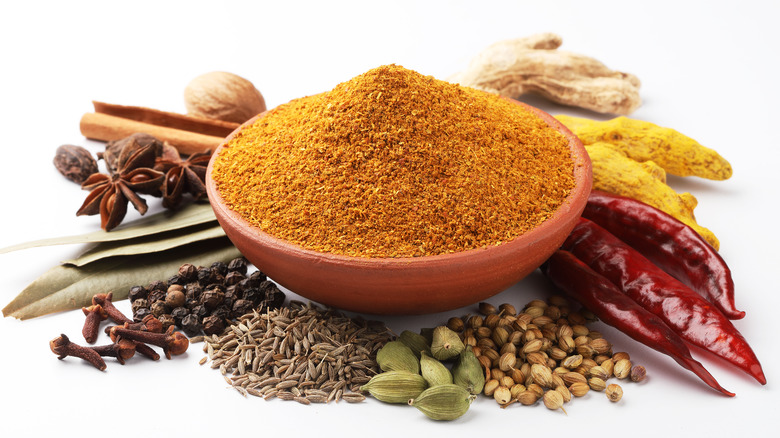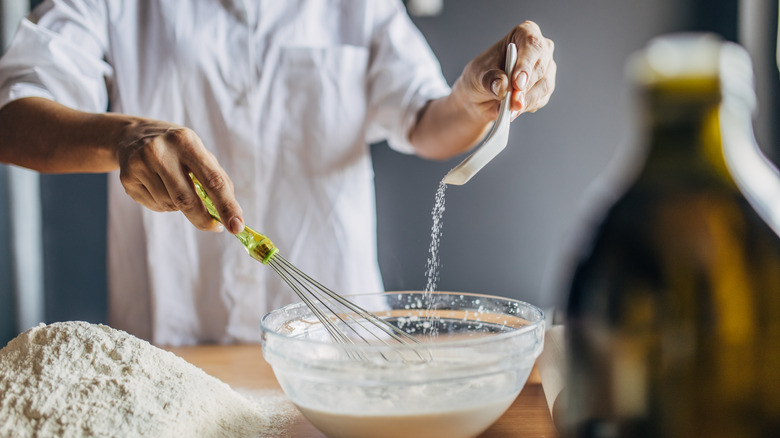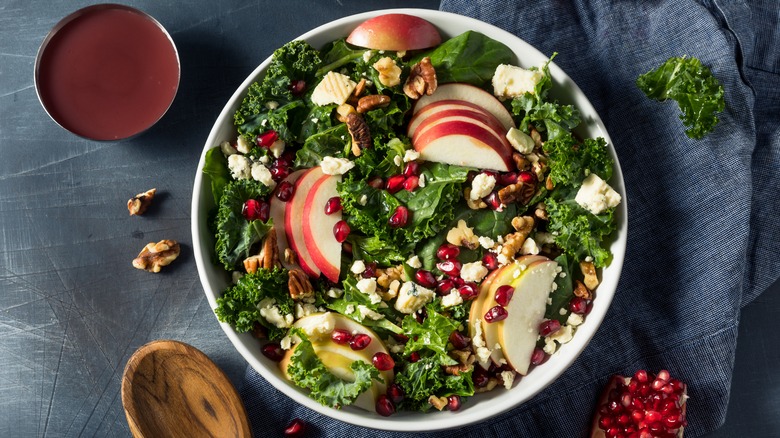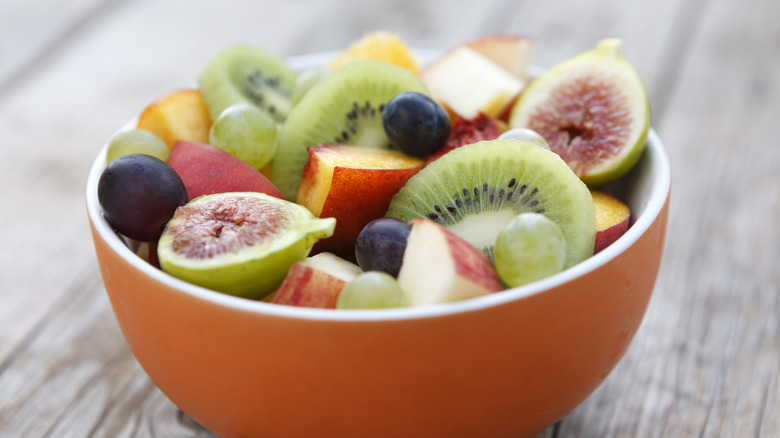11 Creative Ways To Use Pomegranate Peelings
One word to describe a pomegranate is odd. Colorful yet quasi-alien, it's a head-scratcher that's understandably intimidating to first-timers. Unlike most fruits at grocery stores, pomegranates have piths filled with about 600 tiny edible seeds called "arils" rather than flesh. Upon opening a pomegranate, the juice-packed seeds taste bittersweet and have a crunchy bite commonly found in smoothies, salads, savory meat dishes, and more.
While pomegranate arils are seemingly the star of the experience, the fruit itself is composed of several parts that can be used for cooking and in other surprising ways. Pomegranates are renowned for being rich in antioxidants, but the real kicker is that the peel contains more than the fruit juice itself, per Healthline. However, pomegranate peels are often thrown out because people believe that they are inedible. Although that's true for their natural state, you can enjoy them in just a few easy steps.
From calming beverages and fruity blends to elevated baking and aromatic dishes, pomegranate peel is tasty and nutritious. Here is a list of creative ways to use pomegranate peels.
Brew a nutritious tea with pomegranate powder
According to Statista, about 6.7 billion kilograms (or over 14,000,000,000 pounds) of tea was consumed in 2022, and that number is expected to hit 7.4 billion kilograms by 2025. It's not hard to see why. Tea is an enriching and versatile beverage that is enjoyable hot or cold, while offering taste, nutrition, and sometimes, a kick of caffeine.
You would have never guessed it, but pomegranate peels can become a nutritious tea. By dehydrating them, the peels are then ground into a powder and put into a tea bag. Beyond its unique taste, there are several benefits to drinking pomegranate peel tea. In a video shared on Instagram, content creator Armen Adamjan demonstrated the dehydration method and said the pomegranate can help with sore throats, coughs, and stomach problems and boosts bone health.
To make the powder, put the peelings into a baking pan along with the light-colored membrane. Bake them in the oven at 350 F for 20 minutes, or if patience is your strongest virtue, let them sit in the sun to dry for three days. Once dry, use a blender or coffee grinder to turn the peels into powder, put it into a tea bag, and enjoy.
Exfoliate your skin with pomegranate peels and lemon juice
Learning how to make pomegranate powder will open up a whole new world of useful possibilities. Tea is but one of several amazing things that you can make. Mixing a little water with pomegranate powder can create a powerful exfoliant for your skin. TikTok content maker Carleigh Bodrug raised the eyebrows of scrappy cookers everywhere when she pulled this pomegranate trick from her sleeve. While demonstrating, she made sure to highlight a common opinion: pomegranate peel powder is more nutritious than the actual aril seeds.
It only takes a couple of minutes to create the exfoliating paste. Pour the pomegranate powder into a small bowl with a bit of water. Mix the ingredients until the consistency becomes paste-like yet still grainy. It can also be used as a facial mask beside its exfoliating purposes. For a deeper and more thorough cleanse, add some lemon juice to the mix. The juice has a natural acidity and does a good job of removing dead skin cells.
Ease and cure upset stomachs
Turbulent tummies are the worst. There is no wonder they call it "gut-wrenching" — a bad one can feel like a hand is angrily clenching your stomach. Thankfully, nature is filled with remedies that'll settle your stomach's storm, and pomegranates can do the trick. According to a study published in Nature Communications, scientists from the Institute for Stem Cell Biology and Regenerative Medicine and the University of Louisville found that pomegranates contain a microbial metabolite called Urolithin A, which reduces gut inflammation, mitigating inflammatory bowel disease (IBD). IBD is an umbrella term that can include symptoms like abdominal pain, diarrhea, fever, and weight loss, amongst other things. Further studies from the journal Frontiers in Nutrition confirm that pomegrante peels are especially rich in this compound.
In Indian culture, pomegranates have been part of Ayurvedic practices for generations as an essential medicinal ingredient. If it's been supposedly alleviating stomach aches for thousands of years, there must be something to it. This is another creative use for pomegrante peels that comes from using tea. While consuming pomegranate peel powder tea is one way to reduce symptoms, there's another option if you're short on time. The powder can also be purchased and consumed in capsule form.
Make a bowl of savory Indian pindi chana
Indian cuisine dates back thousands of years to the Vedic Period, which lasted from the 15th to the 5th century B.C. Its rich history runs so deep that even today, there are still dishes that can only be found in India. Pindi chana is a lesser-known dish that originates from a town it was named after, Rawalpindi, in Punjab, Pakistan. It's a variation on another popular chickpea curry dish called chole, which is coated with gravy, whereas pindi chana is served dry.
Delicious, vegan-friendly, and loaded with protein, pindi chana is a simple dish made with chana masala powder, dried Indian gooseberry or tea leaves, and ... wait for it ... pomegranate powder. The pomegranate powder gives the dish a sour and acerbic kick backed by a layer of red fruit that balances perfectly with the aromatic and savory notes. It's typically served hot with puri, rotis, or naan.
Transform pomegranate peels into a robust curry sauce
Indian cuisine is considered one of the best in the world for a reason, including that it often incorporates medicinal herbs and spices. Curry, for example, can allegedly reduce internal inflammation, improve heart health, and boost digestive health, per Healthline. And that's all while bringing a satisfying end to your hunger pangs. Dalimba solla khadi is supposedly a special health-boosting curry that originates from the land of Konkan, located along the west coast of India. It's typically consumed as a home remedy for amoebic dysentery, chronic diarrhea, and other digestive issues.
The special ingredient in dalimba solla khadi that's responsible for easing those symptoms is none other than pomegranate peel powder. Creamy and hearty with a bittersweet twist, this is certainly not your everyday curry. Traditionally, digestive issues are remedied by a three-prong approach: Consume pomegranate seeds, followed by pomegranate peel broth, and finally, a bowl of dalimba solla khadi and rice for sustenance. It's a super easy recipe that takes about 30 minutes to make and is sure to keep your tummy ache-free.
Enrich your morning smoothies
Whether you prefer a revitalizing coffee blend or a relaxing herbal tea, starting the morning with the right beverage can make or break your day. Smoothies are delicious and versatile methods to jumpstart your daily routine. According to Grand View Research, the worldwide smoothie market was valued at $6.68 billion in 2021 and is expected to grow 9.3% between 2022 and 2028. The growth of this food continues to mirror a rise in health awareness, and nutrient-dense superfood ingredients like pomegranate peelings are in for the ride.
It's all the more reason to infuse your blended beverage with sweet and tangy pomegranate peel powder. Aside from being a tasty alternative to herbal teas and capsule vitamins, pomegranates are considered a "superfruit" because they are loaded with antioxidants with numerous benefits. Adding pomegranate arils to your smoothie is nothing new, but you're missing 50% of the fruit when you throw away the peel.
Use pomegranate peelings to extend the shelf life of stored foods
Knowing how to store food properly can save you from making unnecessary trips to the grocery store. Since before refrigerators were invented, we've wrestled with the best way to preserve food. Thankfully, we've made significant strides toward an expiration-date-free reality, and various storage options are readily available at a stone's throw in any direction.
Whether your fridge is organizational perfection or a random jumble of aluminum and plastic wrap, you can benefit from the preservation powers of pomegranate peel powder or extract. Multiple studies have confirmed that pomegranate peels contain antimicrobial properties that reduce bacteria growth. A 2021 study published in the journal Foods found that fruit salad showed slower signs of decay when stored with pomegranate peel powder at 41 F for 28 days. Another 2023 study, also published in Foods, noted that pomegranate peel powder was effective as a natural preservative for high-quality beef sausages.
Beyond fruits and meats, studies cover a wide range of foods that can benefit from pomegranate peel powder's preservation powers. Ravioli was used in a 2022 study published in LWT Food Science and Technology. The ravioli with pomegranate powder in the filling and dough lasted in the refrigerator for three to eight days longer than the control ravioli that did not have the powder. The latter only lasted a little less than two days.
Boost the nutrients of baked goods with pomegranate peel
When you think of healthy eats, baked goods are probably the last thing that comes to mind. Butter, carbs, and sugar are the trifecta of the baking world. But a baked good can also be nutritious — powder made from pomegranate peelings is the perfect additive to your cookies. According to a 2022 study published in the Journal of Food Science and Technology, adding that special ingredient to cookie batter boosts the nutrient content without impacting the quality.
The study additionally found that pomegranate peel powder is suitable for enriching bakery products because it has more fiber, fat, and protein than wheat flour. It noted that fiber-rich ingredients can reduce LDL ("bad") cholesterol, hypertension, and hyperlipidemia. The latter can increase the risk of heart attack, stroke, and peripheral artery disease, according to the University of Pittsburgh Medical Center. That said, the study concluded that pomegranate peel powder should be used in moderation because adding too much not only darkens the appearance but increases the moisture content, thereby giving baked goods a gummy consistency.
In terms of finding the right ratio, it's suggested that the pomegranate peel powder measurement should be no more than 5% of the amount of flour that your recipe calls for. Say you're making a basic 1-2-3-4 cake, which requires 3 cups of flour. In this case, you would replace 0.15 U.S. cups of flour with pomegranate peel powder.
Spread some tart goodness across salads
Salads leave the door open to all sorts of culinary possibilities. From the types of greens you choose to the endless number of savory, sweet, or herbaceous toppings, it's one of the most exciting ways to experiment in the kitchen. Give your next salad creation a sweet and tangy touch with pomegranate peel powder for an extra dose of antioxidants. Pair or use it as a substitute for pomegranate arils. For first-timers, we suggest starting with just 1 teaspoon of powder before increasing the amount as desired.
A simple arugula, orange, and pomegranate salad is a great recipe to experiment with. It's a versatile option that you can whip out for fancy dinners or laid-back afternoon snacks. Another sprinkle-ready dish is this refreshing and fiber-rich wheat berry and pomegranate salad recipe; it'll give you the midday fuel you need and only requires a few ingredients. Hearty salad lovers will also enjoy this roasted pumpkin and pomegranate salad recipe by Katie Lee. With countless salad recipes to try, we've no doubt you'll be in pomegranate heaven.
Add even more flair to fruit bowls with pomegranate peels
Few things give you life like a refreshing ripe fruit salad on a hot summer day especially when it contains a harmonious pairing of sweet, sour, and citrusy fruits. When picking out fruit bowl ingredients, we highly suggest adding pomegranate peel powder to the list. Using it as a substitute for arils will amp up a purportedly nutritious treat with even more nutrients. It has a robust tart taste that pairs best with fruits like blueberry, raspberry, and strawberry, along with apples and citrus varieties.
The combinations are never-ending; you can also sprinkle it atop mango, pear, and pineapple. As mentioned, pomegranate peel powder is a preservative, so it will also extend the shelf life of your fruit by increasing its moisture retention. The benefits are simply hard to beat. That said, be mindful of how much you use. Due to its strong flavor, it can easily overpower the other ingredients. To ensure you have a balanced salad, we suggest experimenting with 1 teaspoon of powder to start.
Make pomegranate peel powder toothpaste
The potential benefits that pomegranate peels offer include tooth decay prevention. According to Netmeds, the fruit peel extract is a common ingredient used in mouthwash and toothpaste. It notes that the powder may be an effective defense against plaque formation, tooth and gum diseases, and other dental ailments. Similar to how you make pomegranate peel tea, the powder can be combined with water and used for gargling. All you need are 2 tablespoons of it, a pot of boiling water, and a strainer to filter the powder out. Equally amazing, rubbing the powder directly onto your gums can possibly reduce symptoms of inflammation, swelling, and bleeding.
If that doesn't impress you, you'll be over the moon when you experience the benefits of pomegranate peel powder toothpaste. The best part is that it's extremely easy to make, and the additional ingredient required is ground black pepper. Mix the powder and pepper, apply it to your toothbrush, and scrub away. Both pomegranate and black pepper are rich in antioxidants and may reduce inflammation. The pepper grains provide abrasion that helps remove plaque and, it may also increase nutrient absorption so that with each scrub, your teeth will receive the potential health benefits.

